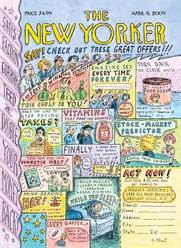Emdashes—Modern Times Between the Lines
The Basics:
About Emdashes | Email us
Ask the Librarians
Best of Emdashes: Hit Parade
A Web Comic: The Wavy Rule
Features & Columns:
Headline Shooter
On the Spot
Looked Into
Sempé Fi: Cover Art
Sempé Fi (On Covers): Caveat Emptorium's Wonder Emporium
Filed under: Sempé Fi Tagged: art, Bernard Madoff, Bernie Madoff, cartoons, comics, covers, David Remnick, Pollux, Rafael AlbertÃ, Ron Chernow, Roz Chast

Pollux writes:
The pirates fired their grappling hooks into the sides of the ship, and reeled in their prize. They boarded the vessel and set up a television set and forced the crew, at ballpoint, to watch their sinister programming. They bombarded the crew with ad after ad, and afterward handed out newsletters, brochures, vouchers, catalogues, and promotional DVDs.
The US Navy arrived too late: the crew had already had their credit cards swiped against portable, wireless credit card terminals. E-mail receipts had been sent immediately. It all happened so quickly.
The crew bought face cream that kept a person young forever; stock market predictors; vitamins that made you smarter (you have to be stupid not to buy them); guides to turn your children into domestic servants and to avoid paying taxes; mind-reading hats; and candy bars that burn five-hundred calories as you eat them. Amazing! It really works!
Who wouldn’t want to build muscles and learn a foreign language and earn big bucks while you sleep? Who wouldn’t want amazing sex every time forever? Astonishing!
All you have to do is send a check for $25,000,000 (per item) to Madoff Industries. Yes, the one on Old Ponzi Boulevard. And then, in about 6-8 weeks, you’ll get your appetite reducers that will trim down your weight to ridiculous levels and your male enhancers that will really turn your private life around and leave her begging for more.
Or you might not. They already have your money, and good luck getting it back.
“April Fool” is the title of the cover for the April 6, 2009 issue of The New Yorker. It was drawn by Roz Chast, a master of the multi-paneled, multi-gag cartoon. Chast, a veteran staff cartoonist since 1978 for The New Yorker (which has run more than a thousand of her cartoons), creates illustrations that seem, at first glance, to be light, improvised, and airy, as if quickly sketched out in a well-worn drawing pad, dabbed with color, scanned, and e-mailed to the New Yorker HQ, all in the space of a few minutes. But they are laden with substance and significance. For Chast, whom Emily interviewed in 2006, “writing is always patching together stuff that happened, stuff that never happened, stuff you wish happened, stuff you would dread happening…” And Chast’s cover “April Fool” falls under the last category.
The materialistic frenzy that pervades our society is very sinister and very real. Chast’s ads are not as fantastical as one may think. I have seen ads on TV that promise to teach me Albanian and Hittite in the space of a week. Rafael AlbertÃ’s poem, “The Avaricious Angel,” captures the mania caused by insatiable greed, the kind of voracity that causes a living death: “That man is dead / and doesn’t even know it./ He wants to rob the bank, / steal clouds, stars, golden comets, / to buy the scarcest thing: / heaven. / And he’s a dead man.”
Chast’s drawings inhabit what New Yorker Editor-in-chief David Remnick has described as “really weird corners of domestic and psychic life.” Chast’s explorations of domestic anxiety, but this sense of anxiety has no longer become the preserve of individuals.
Domestic anxieties have become national ones. We live in a land of promises propped up by hopes of easy money and quick returns. It has been acceptable and encouraged, a mode of thinking that is becoming unhinged by national catastrophe caused by toxic mortgages and default credit swaps and other financial tricks that I for one have yet to understand.
The dreamland of America can become a nightmare complete with Dali-esque melting clocks and burning giraffes with mouths stuffed with money -our money. And it’s burning too.
“In my mind’s eye I will always be a short, frizzy-haired twelve year old,” Chast has remarked, but her cartoons reflect the viewpoint of an adult who has looked right through the hucksters and promoters and seen the ugliness. The balloon has popped, but Chast isn’t weeping as a child would, but making us laugh by means of her very sharp pen and sharp mind. She, after all, has momentarily popped the balloon that distracted us from the reality of the worst of American materialism and consumerism. We have all been April fools, bamboozled by American businessmen, scrubbed clean, waving offers and making false promises.
As Ron Chernow points out in his March 23, 2009 article for The New Yorker, Madoff put on a “bravura performance” as a man who pretended to not want people’s money, posing as “a man beleaguered by his own generosity, who took on new clients as a favor to friends.” Despite his thespian abilities, Madoff showed signs of inner turmoil. “Only his facial twitches,” Chernow writes, “and the ghost of an old stammer gave the lie to his calm, avuncular image.”
Madoff isn’t the exception; he is simply a high-profile businessman who was caught. Much has been made of Madoff’s mysterious smirk. I myself have examined it. Now Chast allows us to smirk back at those who would lure us to our collective destruction with promises of golden comets, lucky quarters, and lottery-winning secrets.




